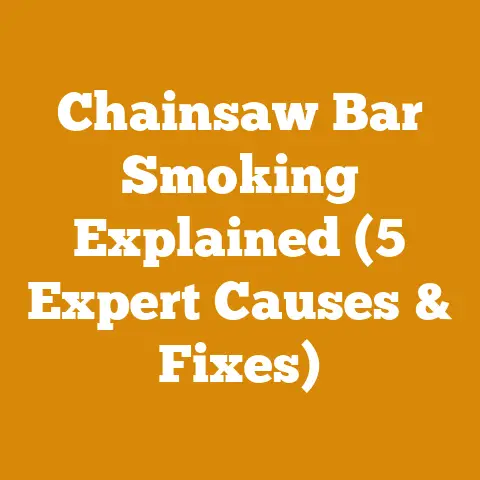When to Replace Chainsaw Chain (5 Key Signs Every Logger Knows)
Have you ever felt that sinking feeling, deep in your gut, when you’re mid-cut, the saw is screaming, and… nothing? The chain is dull, the wood is fighting back, and the job that should take minutes stretches into an agonizing eternity. I know I have. More times than I care to admit. That’s why knowing when to replace your chainsaw chain isn’t just about efficiency; it’s about safety, prolonging the life of your saw, and preserving your sanity. Let’s dive into the five key signs every logger knows, the signs that scream, “It’s time for a new chain!”
5 Key Signs It’s Time for a New Chainsaw Chain
I’ve spent years in the woods, felling trees, bucking logs, and prepping firewood. I’ve learned to listen to my saw, to feel its rhythm, and to recognize the subtle cues that tell me when something isn’t right. A dull chain is more than just an inconvenience; it’s a hazard. It can lead to kickback, increased strain on the saw motor, and even personal injury. So, pay attention to these signs. Your safety and your saw’s longevity depend on it.
1. Sawdust Instead of Chips: The First Warning Sign
One of the first and most obvious indicators that your chainsaw chain is losing its edge is the type of material it’s producing. A sharp chain will eject large, uniform chips of wood. These chips are a sign of efficient cutting, indicating that the chain is biting deeply and cleanly into the wood fibers.
However, when the chain becomes dull, it starts to produce fine sawdust instead of these characteristic chips. This sawdust is a result of the chain scraping and grinding its way through the wood, rather than slicing through it with precision. The difference is significant, both in terms of cutting efficiency and the strain it puts on the saw.
- Sharp Chain: Produces large, uniform wood chips.
- Dull Chain: Produces fine sawdust.
My Experience: I remember one particularly stubborn oak I was trying to fell. The saw was bogging down, and all I was getting was a cloud of fine sawdust. I initially blamed the oak’s density, but after switching to a freshly sharpened chain, the difference was night and day. The new chain threw out massive chips, and the oak went down with ease.
Practical Tip: Regularly check the material your saw is producing. If you notice a shift from chips to sawdust, it’s time to sharpen or replace your chain.
2. Increased Cutting Time and Effort: The Performance Lag
A sharp chainsaw chain should glide through wood with relative ease, requiring minimal effort from the operator. When the chain is dull, you’ll notice a significant increase in the time and effort required to make a cut. The saw may bog down, vibrate excessively, and require you to apply more pressure to maintain the cutting speed.
This performance lag is not only frustrating but also potentially dangerous. Applying excessive force can lead to loss of control and increase the risk of kickback. Moreover, forcing a dull chain to cut puts undue strain on the saw’s motor, potentially shortening its lifespan.
- Sharp Chain: Cuts quickly and efficiently with minimal effort.
- Dull Chain: Cuts slowly, requiring more force and causing the saw to bog down.
Measurement: To quantify this, try timing how long it takes to cut through a standard log with a sharp chain. Then, time the same cut with a chain you suspect is dull. A significant increase in cutting time (e.g., more than 25%) is a strong indicator that the chain needs attention.
Example: A 10-inch diameter pine log should take approximately 10-15 seconds to cut through with a sharp chain. A dull chain might take 20-30 seconds or longer.
Insight: The type of wood also affects cutting time. Hardwoods like oak and maple will naturally take longer to cut than softwoods like pine and fir. However, the relative difference in cutting time between a sharp and dull chain will remain significant regardless of the wood type.
3. The Saw Pulls to One Side: Uneven Cutting
Another telltale sign of a dull or damaged chainsaw chain is its tendency to pull to one side during a cut. This uneven cutting is often caused by uneven wear on the cutting teeth or damage to one side of the chain.
When the teeth on one side of the chain are duller or more damaged than those on the other side, the saw will naturally veer towards the side with the sharper teeth. This can make it difficult to maintain a straight cut and increase the risk of pinching the bar.
- Even Cutting: The saw cuts straight and true.
- Uneven Cutting: The saw pulls to one side during the cut.
Diagnosis: Carefully inspect the cutting teeth on both sides of the chain. Look for signs of uneven wear, damage, or missing teeth. If you notice a significant difference between the two sides, it’s likely the cause of the pulling.
My Troubleshooting: I once had a chain that was pulling severely to the left. After a close inspection, I discovered that several teeth on the right side were chipped and damaged from hitting a rock. Replacing the chain immediately solved the problem.
Safety Note: Attempting to force a saw with a pulling chain can be dangerous. The uneven cutting can lead to kickback or loss of control. It’s always best to address the issue before continuing to work.
4. Visible Damage to the Cutting Teeth: The Obvious Clue
A visual inspection of the cutting teeth is crucial for determining the condition of your chainsaw chain. Look for any signs of damage, such as:
- Rounded Corners: The sharp corners of the cutting teeth should be crisp and well-defined. Rounded corners indicate that the teeth have been worn down and are no longer able to bite into the wood effectively.
- Chipped or Broken Teeth: Any chips or breaks in the cutting teeth will significantly reduce their cutting ability. Even small chips can negatively impact performance.
- Cracked Teeth: Cracks in the cutting teeth are a sign of serious damage and can lead to tooth failure. A cracked tooth can break off during operation, posing a safety hazard.
- Blueing: A blue discoloration on the cutting teeth indicates that they have been overheated. This can happen if the chain is run dull for an extended period or if it’s not properly lubricated. Overheating weakens the steel and makes the teeth more prone to damage.
Detailed Inspection: Use a magnifying glass to closely examine the cutting teeth. Pay particular attention to the cutting edges and the corners.
Prevention: Regularly clean your chainsaw and chain to remove dirt and debris, which can accelerate wear and tear. Always use the correct chain oil to ensure proper lubrication.
Replacement Criteria: If you find significant damage to multiple teeth, it’s generally best to replace the chain rather than attempt to sharpen it. Severely damaged teeth may be difficult or impossible to restore to their original shape.
5. Excessive Vibration: The Uncomfortable Warning
While some vibration is normal during chainsaw operation, excessive vibration can be a sign of a dull or damaged chain. When the chain is not cutting efficiently, the saw’s motor has to work harder to maintain its speed. This increased effort can translate into more noticeable vibration.
Excessive vibration can also be caused by uneven wear on the chain or damage to the bar. If the chain is not properly seated in the bar groove, it can vibrate excessively. Similarly, a bent or damaged bar can cause the chain to vibrate.
- Normal Vibration: A smooth, consistent vibration that doesn’t cause excessive discomfort.
- Excessive Vibration: A harsh, jarring vibration that is uncomfortable to hold and can cause fatigue.
Troubleshooting Steps:
- Check Chain Tension: Ensure that the chain is properly tensioned. A loose chain can vibrate excessively.
- Inspect the Bar: Check the bar for any signs of damage, such as bending, cracking, or excessive wear.
- Examine the Chain: Look for signs of uneven wear, damage, or missing teeth.
- Lubrication: Ensure the chain is properly lubricated.
Impact on the User: Prolonged exposure to excessive vibration can lead to hand-arm vibration syndrome (HAVS), a serious condition that can cause numbness, tingling, and pain in the hands and fingers. Addressing the issue of excessive vibration is crucial for protecting your long-term health.
My Experience: I ignored excessive vibrations for a few weeks on a job, thinking it was just part of the wear and tear. Eventually, I started noticing numbness in my fingers after long days. After replacing the chain and the bar, the vibrations disappeared, and the numbness subsided. It was a hard lesson learned about listening to my body and my equipment.
Understanding Chainsaw Chain Types and Their Lifespan
Not all chainsaw chains are created equal. Different chain types are designed for different applications and have varying lifespans. Understanding the different types of chains and their intended use can help you choose the right chain for your needs and maximize its lifespan.
Types of Chainsaw Chains
- Full Chisel Chains: These chains have square-cornered teeth that provide the fastest and most efficient cutting. They are ideal for experienced users who are working with clean wood and require maximum performance. However, full chisel chains are more prone to damage from dirt and debris and require more frequent sharpening.
- Semi-Chisel Chains: These chains have rounded-corner teeth that are more durable and forgiving than full chisel chains. They are a good choice for users who are working in dirty or abrasive conditions or who are less experienced with chainsaw operation. Semi-chisel chains offer a good balance of cutting speed and durability.
- Low-Profile Chains: These chains are designed for safety and are often used on smaller chainsaws. They have a lower kickback potential than full or semi-chisel chains. Low-profile chains are a good choice for homeowners and occasional users.
- Ripping Chains: These chains are specifically designed for cutting wood parallel to the grain, such as when milling lumber. They have a different tooth geometry than standard chains and are not suitable for cross-cutting.
Chain Selection: Choosing the right chain type for your application is crucial for maximizing performance and extending chain life. Consider the type of wood you’ll be cutting, the conditions you’ll be working in, and your level of experience.
Factors Affecting Chain Lifespan
Several factors can affect the lifespan of a chainsaw chain, including:
- Wood Type: Hardwoods like oak and maple will wear down a chain faster than softwoods like pine and fir.
- Cutting Conditions: Working in dirty or abrasive conditions will accelerate wear and tear on the chain.
- Maintenance: Regular sharpening and proper lubrication are essential for extending chain life.
- User Technique: Using proper cutting techniques can reduce strain on the chain and prevent damage.
- Chain Quality: Higher-quality chains are typically made from stronger materials and will last longer than cheaper chains.
My Recommendation: Invest in a high-quality chain from a reputable manufacturer. While it may cost more upfront, a good chain will last longer and provide better performance in the long run.
Estimating Chain Lifespan
It’s difficult to give a precise estimate of chainsaw chain lifespan, as it depends on so many variables. However, here are some general guidelines:
- Homeowners: A homeowner who uses their chainsaw occasionally for light tasks may be able to get several years of use out of a single chain.
- Professional Loggers: A professional logger who uses their chainsaw daily may need to replace their chain every few weeks or even days, depending on the conditions.
Tracking Chain Use: Keep a log of your chainsaw use and chain replacements. This will help you estimate how long your chains typically last under your specific working conditions.
Replacement Strategy: It’s always a good idea to have a spare chain on hand. That way, you can quickly replace a dull or damaged chain and keep working without interruption.
Sharpening vs. Replacing: Making the Right Call
When your chainsaw chain starts to show signs of dullness, you have two options: sharpen it or replace it. Sharpening can restore the chain’s cutting ability and extend its lifespan, but there comes a point when replacement is the more practical and cost-effective choice.
When to Sharpen Your Chainsaw Chain
Sharpening is a good option when the chain is only slightly dull and the cutting teeth are still in good condition. Regular sharpening can help maintain the chain’s performance and prevent it from becoming excessively dull.
Benefits of Sharpening:
- Cost-Effective: Sharpening is generally cheaper than replacing a chain.
- Extends Chain Life: Regular sharpening can significantly extend the lifespan of your chain.
- Maintains Performance: A sharp chain cuts more efficiently and reduces strain on the saw.
Sharpening Tools:
- Hand Files: Hand files are a traditional and inexpensive way to sharpen chainsaw chains. They require some skill and practice to use effectively.
- Electric Sharpeners: Electric sharpeners are faster and easier to use than hand files. They provide more consistent results and are a good choice for users who sharpen their chains frequently.
- Bar-Mounted Sharpeners: These sharpeners attach directly to the chainsaw bar and allow you to sharpen the chain without removing it from the saw.
My Sharpening Routine: I prefer to use a hand file for sharpening my chains. It allows me to have more control over the sharpening process and to fine-tune the cutting edges. I typically sharpen my chain after every few hours of use, or whenever I notice a decrease in cutting performance.
When to Replace Your Chainsaw Chain
Replacement is the better option when the chain is severely damaged, excessively worn, or has had too many sharpening cycles. Attempting to sharpen a severely damaged chain can be time-consuming and may not restore its cutting ability.
Reasons to Replace a Chain:
- Severely Damaged Teeth: If the cutting teeth are chipped, broken, or cracked, it’s best to replace the chain.
- Excessive Wear: If the teeth have been worn down to the point where they are no longer effective, it’s time for a new chain.
- Too Many Sharpening Cycles: Each time you sharpen a chain, you remove a small amount of material from the cutting teeth. After several sharpening cycles, the teeth may become too short to be effectively sharpened.
- Stretched Chain: Over time, the chain can stretch, causing it to become loose on the bar. A stretched chain can be dangerous to operate and should be replaced.
Cost Analysis: Consider the cost of sharpening versus the cost of replacing the chain. If you’ve already spent a significant amount of time and effort trying to sharpen a chain without success, it may be more cost-effective to simply replace it.
Safety Considerations: A severely damaged or worn chain can be dangerous to operate. It can increase the risk of kickback and loss of control. If you’re unsure whether to sharpen or replace your chain, err on the side of caution and replace it.
Step-by-Step Guide to Replacing Your Chainsaw Chain
Replacing a chainsaw chain is a relatively simple process, but it’s important to follow the correct steps to ensure safety and proper operation. Here’s a step-by-step guide:
1. Gather Your Tools and Materials
Before you begin, gather the following tools and materials:
- New Chainsaw Chain: Make sure you have the correct chain for your chainsaw model. Check your saw’s manual or the old chain for the correct pitch, gauge, and drive link count.
- Chainsaw Wrench or Scrench: This tool is used to loosen and tighten the bar nuts.
- Gloves: Wear gloves to protect your hands from sharp edges and dirt.
- Rag or Brush: Use a rag or brush to clean the bar and sprocket.
2. Prepare Your Chainsaw
- Turn Off the Chainsaw: Ensure that the chainsaw is turned off and the spark plug wire is disconnected to prevent accidental starting.
- Position the Chainsaw: Place the chainsaw on a stable surface with the bar facing away from you.
3. Loosen the Bar Nuts
- Locate the Bar Nuts: The bar nuts are located on the side of the chainsaw, near the base of the bar.
- Loosen the Nuts: Use the chainsaw wrench or scrench to loosen the bar nuts. Do not remove them completely.
4. Release the Chain Tension
- Locate the Chain Tensioning Screw: The chain tensioning screw is typically located on the side of the chainsaw, near the bar.
- Loosen the Tension: Turn the tensioning screw counterclockwise to loosen the chain tension.
5. Remove the Old Chain
- Remove the Bar Nuts: Completely remove the bar nuts and the side cover.
- Remove the Old Chain: Carefully remove the old chain from the bar groove and the sprocket.
6. Inspect the Bar and Sprocket
- Inspect the Bar: Check the bar for any signs of damage, such as bending, cracking, or excessive wear. Clean the bar groove with a screwdriver or a bar groove cleaner.
- Inspect the Sprocket: Check the sprocket for wear or damage. A worn sprocket can damage the new chain. Replace the sprocket if necessary.
7. Install the New Chain
- Position the Chain: Place the new chain around the sprocket and into the bar groove. Make sure the cutting teeth are facing in the correct direction (they should point forward on the top of the bar).
- Align the Bar: Align the bar with the mounting studs on the chainsaw body.
- Install the Side Cover: Place the side cover back onto the chainsaw.
8. Tighten the Bar Nuts
- Tighten the Nuts: Tighten the bar nuts finger-tight.
9. Adjust the Chain Tension
- Tighten the Tensioning Screw: Turn the tensioning screw clockwise to tighten the chain. The chain should be snug against the bar but still able to be pulled around the bar by hand.
- Check the Tension: Lift the chain in the middle of the bar. There should be about 1/8 inch of slack.
10. Finalize and Test
- Tighten the Bar Nuts: Fully tighten the bar nuts with the chainsaw wrench or scrench.
- Test the Chain: Start the chainsaw and run it at idle speed. Check that the chain is running smoothly and that the tension is correct.
- Adjust as Needed: If necessary, adjust the chain tension until it is correct.
Important Safety Tip: Always wear gloves when handling chainsaw chains. The teeth are sharp and can easily cut your hands.
My Recommendation: After installing a new chain, run the chainsaw for a few minutes and then re-check the chain tension. New chains tend to stretch slightly during initial use.
Maintaining Your Chainsaw Chain for Longevity
Proper maintenance is crucial for extending the lifespan of your chainsaw chain and ensuring safe and efficient operation. Here are some key maintenance practices:
1. Regular Sharpening
- Frequency: Sharpen your chain regularly, ideally after every few hours of use.
- Technique: Use the correct sharpening tools and techniques to maintain the proper cutting angle and depth.
- Professional Sharpening: Consider having your chain professionally sharpened periodically to ensure optimal performance.
2. Proper Lubrication
- Chain Oil: Use a high-quality chain oil specifically designed for chainsaw use.
- Oil Level: Check the oil level regularly and refill as needed.
- Oiler Function: Ensure that the chainsaw’s oiler is functioning properly and delivering adequate lubrication to the chain.
3. Cleaning
- Regular Cleaning: Clean your chainsaw and chain regularly to remove dirt, debris, and pitch.
- Cleaning Solvents: Use appropriate cleaning solvents to dissolve pitch and other stubborn deposits.
- Bar Groove Cleaning: Clean the bar groove regularly to ensure smooth chain movement.
4. Chain Tensioning
- Regular Checks: Check the chain tension regularly and adjust as needed.
- Proper Tension: Maintain the correct chain tension to prevent excessive wear and ensure safe operation.
5. Storage
- Clean and Dry: Store your chainsaw and chain in a clean, dry place.
- Chain Protection: Consider using a chain guard or scabbard to protect the chain during storage and transport.
6. Bar Maintenance
- Bar Inspection: Regularly inspect the bar for wear, damage, and burrs.
- Bar Dressing: Use a bar dressing tool to remove burrs and smooth the bar rails.
- Bar Rotation: Rotate the bar periodically to distribute wear evenly.
My Pro Tip: After each use, I thoroughly clean my chainsaw, sharpen the chain, and check the bar for any damage. This simple routine helps to keep my saw in top condition and extends the life of my chain and bar.
Safety First: Chainsaw Safety Practices
Chainsaws are powerful and potentially dangerous tools. It’s essential to follow proper safety practices to prevent accidents and injuries.
1. Personal Protective Equipment (PPE)
- Eye Protection: Always wear safety glasses or a face shield to protect your eyes from flying debris.
- Hearing Protection: Wear earplugs or earmuffs to protect your hearing from the loud noise of the chainsaw.
- Head Protection: Wear a hard hat to protect your head from falling branches and other hazards.
- Hand Protection: Wear gloves to protect your hands from cuts, abrasions, and vibration.
- Leg Protection: Wear chainsaw chaps or pants to protect your legs from accidental cuts.
- Foot Protection: Wear sturdy, steel-toed boots to protect your feet.
2. Safe Operating Procedures
- Read the Manual: Always read and understand the chainsaw’s owner’s manual before operating the saw.
- Inspect the Saw: Before each use, inspect the chainsaw for any damage or loose parts.
- Clear the Work Area: Clear the work area of any obstacles, such as branches, rocks, and debris.
- Secure Footing: Maintain a firm and stable footing while operating the chainsaw.
- Two-Handed Grip: Always use a two-handed grip on the chainsaw.
- Avoid Overreaching: Avoid overreaching or cutting above shoulder height.
- Be Aware of Kickback: Understand the causes of kickback and take steps to prevent it.
- Never Cut Alone: Never cut alone in remote areas.
- Take Breaks: Take frequent breaks to avoid fatigue.
3. Kickback Prevention
- Understand Kickback: Kickback is a sudden and forceful backward movement of the chainsaw that can cause serious injury.
- Avoid the Kickback Zone: Be aware of the kickback zone, which is the upper quadrant of the bar tip.
- Use a Reduced-Kickback Chain: Consider using a reduced-kickback chain, especially if you are a beginner.
- Maintain a Sharp Chain: A sharp chain is less likely to kick back than a dull chain.
- Cut at Full Throttle: Cut at full throttle to reduce the risk of kickback.
My Personal Rule: I never compromise on safety. I always wear all of the recommended PPE, and I take the time to properly inspect my saw and clear the work area before each use. I also make sure to stay aware of the kickback zone and take steps to prevent kickback.
Final Thought: Chainsaw safety is not just a set of rules; it’s a mindset. By following proper safety practices, you can significantly reduce your risk of injury and enjoy the benefits of using a chainsaw safely and effectively.
Replacing a chainsaw chain is an inevitable part of chainsaw ownership. By understanding the signs that indicate it’s time for a new chain, you can maintain your saw’s performance, ensure your safety, and prolong the life of your equipment. Remember to choose the right chain for your needs, maintain it properly, and always prioritize safety. With a little knowledge and care, you can keep your chainsaw running smoothly for years to come.






